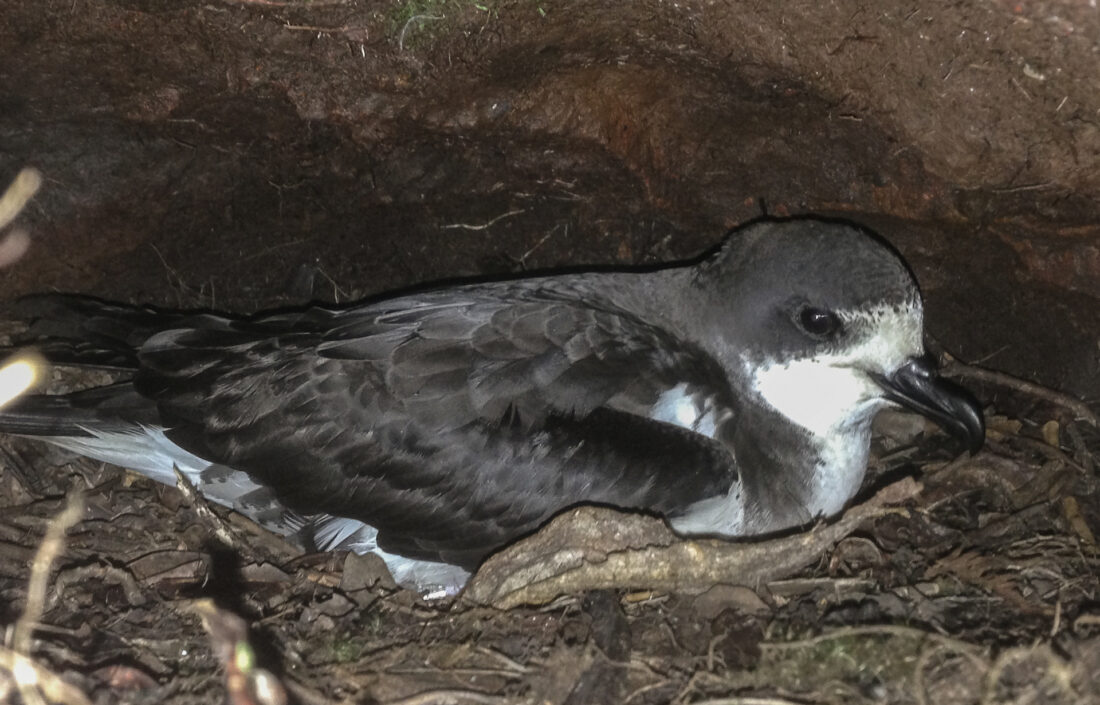Hawaiian Petrel

Status: Indigenous to Hawai’i, IUCN: Vulnerable
Hawaiian Name: ‘Ua‘u
Scientific Name: Pterodroma sandwichensis
Family: Procellariidae
Population: ‘Ua‘u breed on Maui, Hawai‘i, Kaua‘i, Moloka‘i, Lāna‘i, and possibly O‘ahu. Outside the breeding season, ‘ua‘u are most common near nesting colonies but may range as far as 1,300 kilometers (800 miles) from land.
Feeding: Even during the breeding season, ‘ua‘u often feed thousands of kilometers from colonies, usually foraging with mix-species feeding flocks. In Hawai‘i, ‘ua‘u feed primarily on squid, goatfish, lantern fish, and crustaceans.
Breeding: ‘Ua‘u nest in colonies, form long-term pair bonds, and return to the same nest site year after year. They lay one egg and raise one chick per breeding season. Both parents incubate and feed their chick. Colonies are typically located in high elevation, xeric habitats or wet, dense forests. ‘Ua’u nest in burrows, crevices, or cracks in lava tubes
Life Cycle: Adult ‘ua’u arrive on land in March or April. The female lays a single egg in May or June. Both parents take turns incubating for 60 days and feed the chick until it fledges in November or December. Birds likely first breed at five to six years of age.
Cultural Information: Early Hawaiians were though to have considered ‘ua’u chicks as a delicacy. Chicks were reserved for consumption only by ali’i (Hawaiian royalty). The ali’i sent their workers to gather the young birds by inserting sticks into the nesting burrows, twisted the stick into the downy feathers of the chicks and then pulling the chicks out of the nest. ‘Ua’u were also caught as they flew to their nests at night by nets that were placed along mountain ridges.
Conservation: ‘Ua’u have many threats including introduced predators. Adults and chicks are susceptible to depredation by dogs, pigs, rats, barn owls, feral cats, and mongoose. The presence of these destructive introduced animals, the main force behind population decline, has relegated the species now to nest only in remote interior areas, at high altitudes, or on islands that are predator-free. Feral goats, sheep, and potentially deer trample burrows and degrade nesting habitat.
PRC and ‘Ua‘u: From 2015-2020 we translocated 110 ‘ua’u from montane colonies, to Kīlauea Point National Wildlife Refuge on Kaua’i. The first ‘ua’u returned in 2020 and birds have been breeding at the site since 2021.
Since 2016, PRC has been surveying for ‘ua’u on O’ahu using acoustic recording units and in-person auditory surveys. We have detected ‘ua’u at Ka’ala and Kaluanui Natural Area Reserves and in the Ewa Forest Reserve.
Sources: ‘Ua’u, the Hawaiian Petrel – Haleakalā National Park (U.S. National Park Service) (nps.gov)
Division of Forestry and Wildlife: Wildlife Program | ‘Ua‘u (hawaii.gov)
